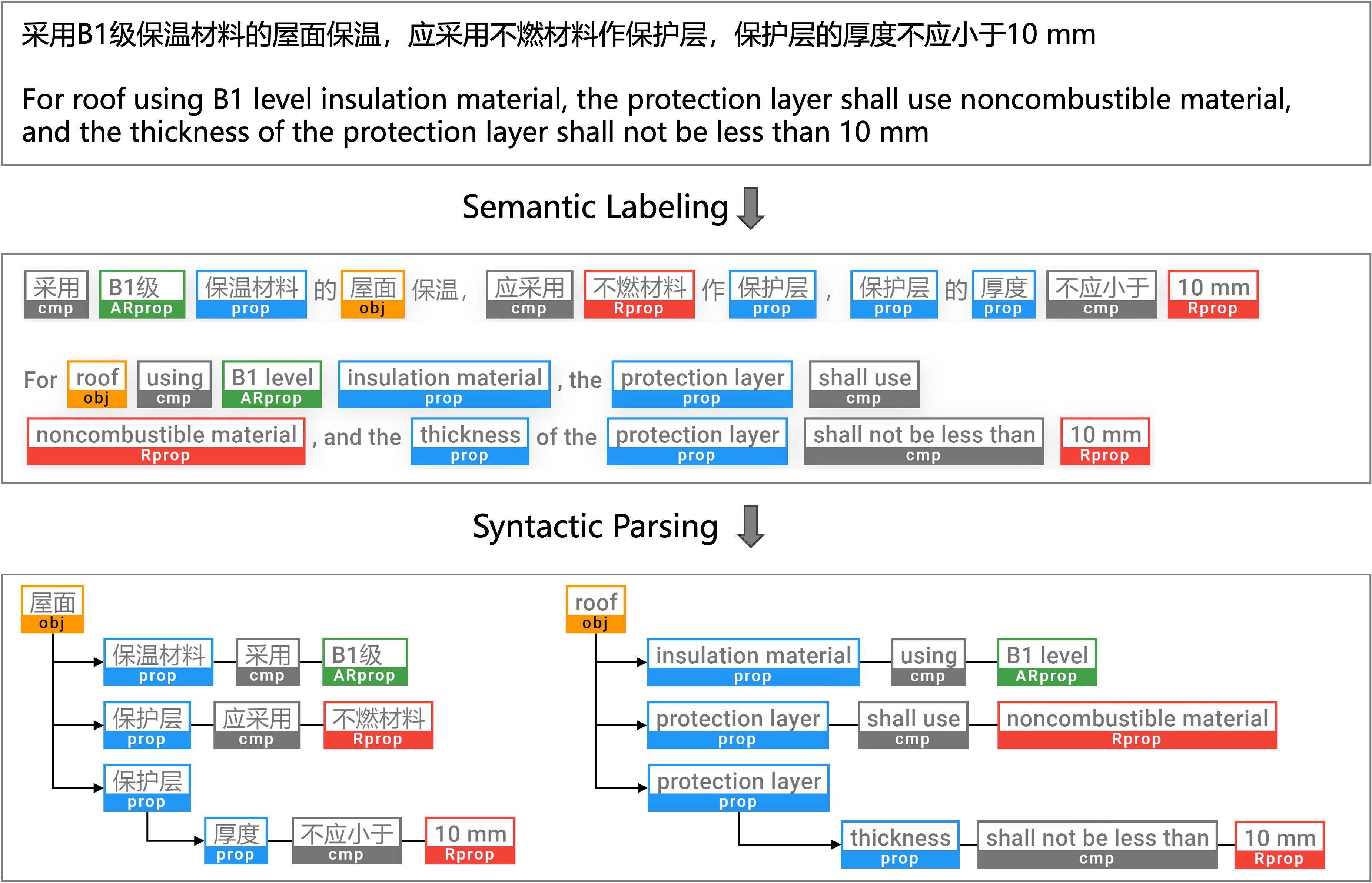Automated rule transformation for automated rule checking.
This repo contains the dataset, codes, and documents for the following paper:
- Y.-C. Zhou, Z. Zheng, J.-R. Lin, X.-Z. Lu, Integrating NLP and context-free grammar for complex rule interpretation towards automated compliance checking, Computers in Industry. 142 (2022) 103746. https://doi.org/10.1016/j.compind.2022.103746.
- Z. Zheng, Y.-C. Zhou, X.-Z. Lu, J.-R. Lin, Knowledge-informed semantic alignment and rule interpretation for automated compliance checking, Automation in Construction. 142 (2022) 104524. https://doi.org/10.1016/j.autcon.2022.104524.
The data/xiaofang/sentences_all.json contains all sentences (in Chinese) with labels developed in this research.
The src/logs/ruleparse-eval.log stores the parsing result (in Chinese) of the dataset in a text-based format (note: VSCode user can install the Log File Highlighter extension and configure it with log-file-highlighter.txt to enable our customized syntax highlight).
The data/docanno/[FireCode_label_merge.json] contains the semantic alignment labels developed in the research.
The data/rules/[建筑设计防火规范-第三章语料-class.txt] contains the text classification labels developed in the research.
This repo uses Pytorch for training deep learning models. Please ensure Pytorch's version >= 1.6 because we use torch.cuda.amp introduced in v1.6 for FP16 acceleration in CUDA device. To use FP32 in CPU device, specify arg --fp16 0 in train.py.
This repo uses BERT model provided by transformers (v2.11) package. By default, the model training uses bert-base-chinese, please download pytorch_model.bin and other json & txt files here and place them in src/models/bert-base-chinese/.
Run train.py in src/ for model training, which will store trained models in src/models/:
python3 train.py
For more information about usages, run python3 train.py -h
To report performance of the model _BertZh0_best.pth, run python3 train.py --report
Run inference.py for semantic labeling , which will use model _BertZh0_best.pth and read all txt files in data/xiaofang/test and store the labeling result in src/logs/predictions:
python3 inference.py
Run ruleparse.py in src/ for syntactic parsing, which will read sentences in data/xiaofang/sentences_all.json and store the result in src/logs/ruleparse-eval.log:
python3 ruleparse.py -d json
To change the dataset of parsing to data/xiaofang/sentences.txt, use the -d argument to specify:
python3 ruleparse.py -d text
To generate the XML check set rules for Autodesk Revit model checker after the parsing, add -g switch (in beta version now):
python3 ruleparse.py -d text -g
To perform interactive rule transformation, run:
python3 ruleparse.py -i
# then input the id of a sentence (ref data/xiaofang/sentence_all.json),
# it will read the sentence and show the parsing result immediately
This function is used to generate SPARQL codes, which can be reasoned by protege, from the semantic labeling results (i.e., data/xiaofang/sentences.txt)
The unsupervised learning-based semantic alignment methods (e.g., the word2vec techniques) and rule-based conflict resolution methods are used.
The following steps are required to generate SPARQL automatically.
-
Download the word2vec model from https://pan.baidu.com/s/1MEz7UJqhP0RdEMNqZCBpaQ (password: 49tp), and release them in src/models/
-
Put the input text file into data/xiaofang/sentences.txt
-
Make sure BuildingDesignFireCodesOntology.pkl and BuildingDesignFireCodesOntology.owl are in data/ontology/, which is used for semantic alignment; and classify_keywords.txt is in data/rules, which is used for text classification
-
Run
python rulegen.pyto generate SPARQL. The generated file is in src/logs/rulegen.log
@article{zhou2022a,
author = {Yu-Cheng Zhou and Zhe Zheng and Jia-Rui Lin and Xin-Zheng Lu},
title = {Integrating {NLP} and context-free grammar for complex rule interpretation towards automated compliance checking},
journal = {Computers in Industry},
volume = {142},
pages = {103746},
year = {2022},
doi = {https://doi.org/10.1016/j.compind.2022.103746},
}
@article{zheng2022a,
author = {Zhe Zheng and Yu-Cheng Zhou and Xin-Zheng Lu and Jia-Rui Lin},
title = {Knowledge-informed semantic alignment and rule interpretation for automated compliance checking},
journal = {Automation in Construction},
volume = {142},
pages = {104524},
year = {2022},
doi = {https://doi.org/10.1016/j.autcon.2022.104524},
}
This project is free and open source for universities, research institutes, enterprises and individuals for research purposes only, and the commercial purpose is not permitted.
本项目面向大学、研究所、企业以及个人用于研究目的免费开放源代码,不得将其用于任何商业目的。
